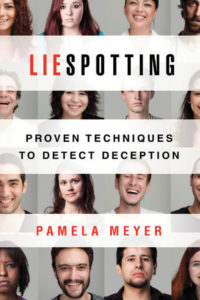Interview by Jenny Anderson, edited by Dorothy Wagener

Lies, cover–ups, and misappropriated funds on the part of college and university officials do severe damage to an institution’s reputation when they come to light. What if there were a way for a senior administrator to uncover and thwart these deceitful practices?
There is, says Pamela Meyer, certified fraud examiner and bestselling author of LieSpotting (St. Martin’s Press, 2010). She isn’t concerned with the little white lies we all tell to ease social interaction, but with the handful of lies we hear daily that, if we only knew the truth they obscure, would affect our decisions regarding work, career, and personal relationships.
Meyer will be a keynote speaker in leadership at NACUBO’s signature workshops during 2013. Participants at the Endowment Management Forum, Student Financial Services Conference, Higher Education Accounting Forum, and Tax Forum will hear her message about confronting deception—at a time when higher education institutions are striving for greater transparency and accountability.
Deception is difficult to detect, Meyer says, because we are “generally hardwired to assume that what we are told is true and that what we see is real.” On the other hand, the art of lying also appears to be hardwired into human brains—even a baby will fake a cry to get a caretaker’s attention.
In interviews conducted by telephone and e-mail, Meyer discusses why people lie, how business officers can scan for deception, and how leaders can build a culture of trust. “It has become ever more urgent for us to rethink how we decide whom to trust,” she says, “for the stakes are extraordinarily high.”
Why Do We Lie?
“A lot of the lies we tell are just white lies to take care of other people,” she says. “We do a lot of this sort of lying, especially as women, to take care of others, to protect them, make them feel better. I don’t actually spend a lot of time talking about those when I speak to audiences. I talk a lot more about high-stakes lies—for example, when a manager misrepresents financial information, when an outside contractor is deceptive, or when an applicant for a job lies.”
There are strong motivations for lying, and Meyer characterizes these as offensive or defensive. Offensively, to advance one’s own position, an individual might lie to:
- Obtain a reward that’s not otherwise easily attainable.
- Gain advantage over another person or situation.
- Create a positive impression and win the admiration of others.
- Exercise power over others by controlling information.
Defensively, for self-protection, an individual might lie to:
- Avoid being punished or avoid embarrassment.
- Protect another person from being punished.
- Protect oneself from the threat of physical or emotional harm.
- Get out of an awkward social situation.
- Maintain privacy.
Are some people more likely to lie than others? “We know from science that extroverts lie more than introverts,” Meyer says. “And, that more-powerful people lie more often and are more comfortable lying—and more comfortable being on the receiving end of lies—than less-powerful people. So, there are certainly studies that point to certain types of liars being more proficient at it in certain ways.
“We don’t yet have research on generational differences. There are significant gender differences in the ways we lie and in our comfort levels with different kinds of lies. But, when we train people in deception detection, we don’t train to look for types; we train to look for indicators of deception.” Through her Washington, D.C.-based training company, Calibrate, Meyer and her team of instructors train investigators, board members, managers, and hiring officers to spot lies through facial micro-expression reading, advanced interrogation techniques, body language analysis, and behavior elicitation. Calibrate also provides insider threat mitigation training to insurance, banking, and legal institutions.
A Trust-Based Infrastructure
For business officers who want to achieve a level of honest communication and address suspected deception, Meyer recommends an important starting point: “Embrace the difficult conversation.
“It’s easy to avoid it,” she says. “Send an e-mail, convey a message through an intermediary, send a signal via an assistant, convene several people in a meeting and cloak your message in indirect terms, hoping the recipient will hear it. But talented leaders bite the bullet and calmly, without judgment, have that difficult conversation in person, one-on-one. Start by embracing the difficult conversation and the facts will unfold.”
For the difficult conversation, Meyer offers steps for getting at the truth. These include asking open-ended questions and not being challenging. “The No. 1 way to put someone on the defensive is to ask, ‘Why?’ Instead, ask, ‘What made you do that?’” she says. Other tactics include studying behavioral clues, sensing incongruous gaps in logic or emotion, and asking questions that confirm your hunches. The goal is to “elicit trust and cooperation from someone you suspect of deceit, not because you want to point the finger at them—quite the opposite, just to focus on the facts.”
Since colleges and universities are under pressure to operate more efficiently and bring their pricing under control, chief business officers are involved in institutionwide change management and may want to commit to a “threat audit” as a matter of good business practice. In LieSpotting, Meyer describes such a process: “A deception or threat audit is an in-depth investigation performed by an objective external set of human capital and information security experts who analyze your organization’s susceptibility to fraud and deception at three levels—policy, infrastructure, and human.”
This process is designed to provide “a clear view of your organization’s vulnerabilities,” and it concludes with recommendations for steps you can take that will deter deception. “Once the retrospective analysis is complete and improved procedures are implemented,” Meyer says, “the seeds of a trust-based infrastructure will be in place.”
An audit can benefit any organization, but it can be especially useful at times of managing a crisis, confronting organizational change, or testing the health of your team before implementing major changes. The audit is conducted in three phases: data collection, corporate incentive structure mapping, and committing to change.
“It’s important to recognize that the audit is merely the first step in a long-term process,” says Meyer. To sustain a culture of trust over the long haul, Meyer recommends investment in the right training and tools, a message of integrity from the top, and consistent and clear consequences for abusers. “The effort you put into making your organization a place where it’s easy to tell the truth will be a small price to pay for the tremendous increase you will notice in productivity, morale, and your own peace of mind,” she says.
Your Personal Board of Directors
Speaking of trust, to whom do you as a leader reach out at critical times? Meyer recommends that business officers deliberately build a secure support system—a personal board of directors she calls a “brain trust.” Once you’ve moved from the stage of protecting yourself against liars to the level of building an infrastructure of trust in your institution, this group can guide you to greater achievement.
“A brain trust is a small, select group of people you choose for their ability to offer ongoing wisdom, expertise, and support as you progress toward your personal and professional goals,” she says. “Besides offering you a regular, trustworthy channel for advice, your brain trust accelerates your learning curve, giving you the benefit of experience while freeing you from having to make every mistake yourself in order to learn from it.”
For your brain trust, choose people from your network whom you trust and most often turn to; consider their personal qualities, their expertise, and their ability to be unbiased. Determine what gaps exist between the skills your candidates offer and the challenges you face. In face-to-face meetings, ask each candidate for specific help, outlining carefully what you need, explaining your expectations, and soliciting honest feedback. Articulate your vision for what you want to accomplish, and keep them apprised of your progress. “Don’t be afraid to ask!” Meyer emphasizes.
Thorough Preparation
The chief business officer’s leadership role extends beyond his or her own staff, as CBOs are frequently called upon to explain higher education finance to stakeholders and the public. Here, also, honest communication is essential.
“I suggest that before public sessions begin, officers clarify what they are willing to share and what they are unwilling to share,” says Meyer. “Preparation is always the key. Often problems arise when officers start halfway into explaining something, and then realize they wish they’d never agreed to begin to answer the question in the first place.
“Be very clear up front with colleagues and yourself about what you are willing to discuss, and then calmly, confidently, and without excuses, hold your ground.”
Similarly, Meyer advocates a straightforward approach to business negotiations. “Once we start breaking through the adversarial standoffs that are too often the starting point for negotiations,” she says, “we open the door for more creative, productive ways to advance our business interests, and we build stronger professional networks along the way.”
To lie-proof a negotiation, Meyer advises starting with the philosophy that your goal is a cooperative negotiation in which each party will be satisfied with the transaction; research shows that individuals with a win-lose approach to negotiation are more likely to lie. Then, invest in thorough preparation to collect and analyze the data you need, as well as identifying issues to be discussed and concessions you’re willing to make. At the meeting, clearly articulate the issues, guide the conversation to address them, and frame the outcome in a positive way.
Seek Authenticity
In all these settings, the leader sets the tone. “How you comport yourself, the messages you send, and the attitude with which you conduct business are indicators of how honest you can expect people around you to be,” Meyer says. “It is vital that you behave in such a way as to make sure the people who work with you know that you’re not just paying lip service to honesty, integrity, and ethical behavior, that they are not just buzzwords in a mission statement or an employee handbook.”
How can you best convey that you yourself are a trustworthy person, so that others have no need to scan you for deception?
“Authenticity makes a huge difference,” says Meyer. “Consistent integrity and fairness—even when toeing a very tough line—will be more respected and associated with honesty than will unpredictable behavior.
“So, be clear about your intentions; communicate well, often, and in person; admit you are wrong when you are wrong; say ‘I don’t know’ when you don’t know; and most importantly, try not to be judgmental of others. Pursue facts, not people.”
JENNY ANDERSON is director, meetings and events, and DOROTHY WAGENER is editor in chief, Business Officer, at NACUBO.




 Citing research that shows most of us encounter up to 200 lies a day, Pamela Meyer is on a mission to help people become more accurate at getting to the truth. Meyer will be a keynote speaker in leadership at NACUBO’s signature workshops during 2013, where her presentations will offer some of her techniques for detecting deception. Look for sessions with Meyer at the following events:
Citing research that shows most of us encounter up to 200 lies a day, Pamela Meyer is on a mission to help people become more accurate at getting to the truth. Meyer will be a keynote speaker in leadership at NACUBO’s signature workshops during 2013, where her presentations will offer some of her techniques for detecting deception. Look for sessions with Meyer at the following events: